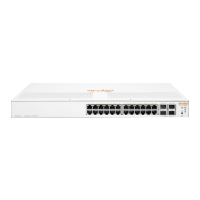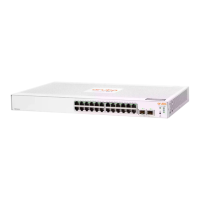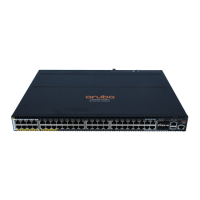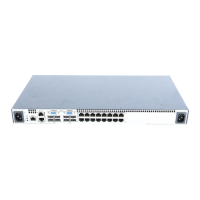switch(config)# show jumbos
Jumbos Global Values
Configured : MaxFrameSize : 9216 Ip-MTU : 9198
In Use : MaxFrameSize : 9216 Ip-MTU : 9198
For more information about frame size, see
Jumbo frames on page 173.
Operating notes for maximum frame size
• When you set a maximum frame size for jumbo frames, it must be on a global level. You cannot use the
jumbo max-frame-size command on a per-port or per-VLAN basis.
• The original way to configure jumbo frames remains the same, which is per-VLAN, but you cannot set a
maximum frame size per-VLAN.
• Jumbo support must be enabled for a VLAN from the CLI or through SNMP.
• Setting the maximum frame size does not require a reboot.
• When you upgrade to a version of software that supports setting the maximum frame size from a version that
did not, the max-frame-size value is set automatically to 9216 bytes.
• Configuring a jumbo maximum frame size on a VLAN allows frames up to max-frame-size even though
other VLANs of which the port is a member are not enabled for jumbo support.
Troubleshooting
A VLAN is configured to allow jumbo frames, but one or more ports drops all inbound
jumbo frames
The port may not be operating at a minimum of 1 Gbps on the other switches covered in this guide. Regardless of
a port's configuration, if it is actually operating at a speed lower than 1 Gbps for the other switches, it drops
inbound jumbo frames. For example, if a port is configured for Auto mode (speed-duplex auto), but has
negotiated a 7 Mbps speed with the device at the other end of the link, the port cannot receive inbound jumbo
frames. To determine the actual operating speed of one or more ports, view the Mode field in the output for the
following command:
show interfaces brief <port-list>
A non-jumbo port is generating "Excessive undersize/giant frames" messages in the
Event Log
The switches can transmit outbound jumbo traffic on any port, regardless of whether the port belongs to a jumbo
VLAN. In this case, another port in the same VLAN on the switch may be jumbo-enabled through membership in
a different, jumbo-enabled VLAN, and may be forwarding jumbo frames received on the jumbo VLAN to non-
jumbo ports.
Fault Finder
Fault Finder is a feature that helps administrators to debug unusual network activity such as flapping links or
transceivers or to troubleshoot issues such as multicast or broadcast storms. Fault Finder helps in preventing
network loops and taking care of situations that arise out of defective equipment and malicious attacks.
The following is the list of issues detected by the Fault Finder:
• Excessive CRC/alignment errors (bad cable)
• Excessive flapping of transceivers (bad transceiver)
178 Aruba 2930F / 2930M Management and Configuration Guide
for ArubaOS-Switch 16.08
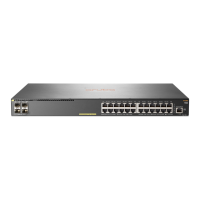
